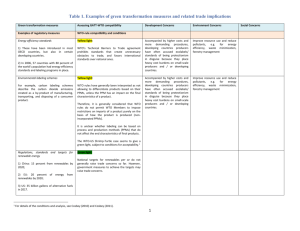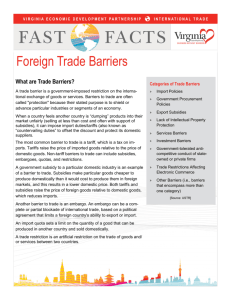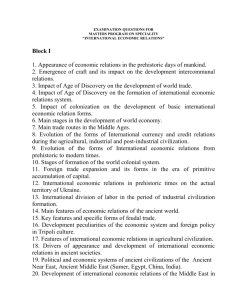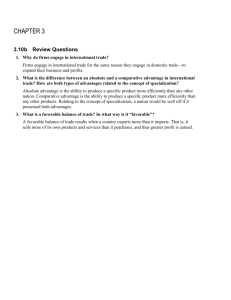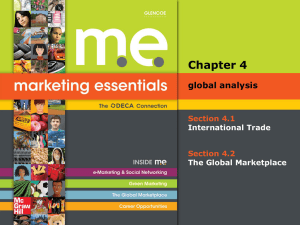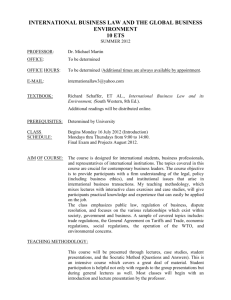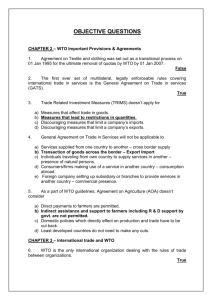1 CHAPTER 6 BUSINESS-GOVERNMENT TRADE RELATIONS 1
advertisement
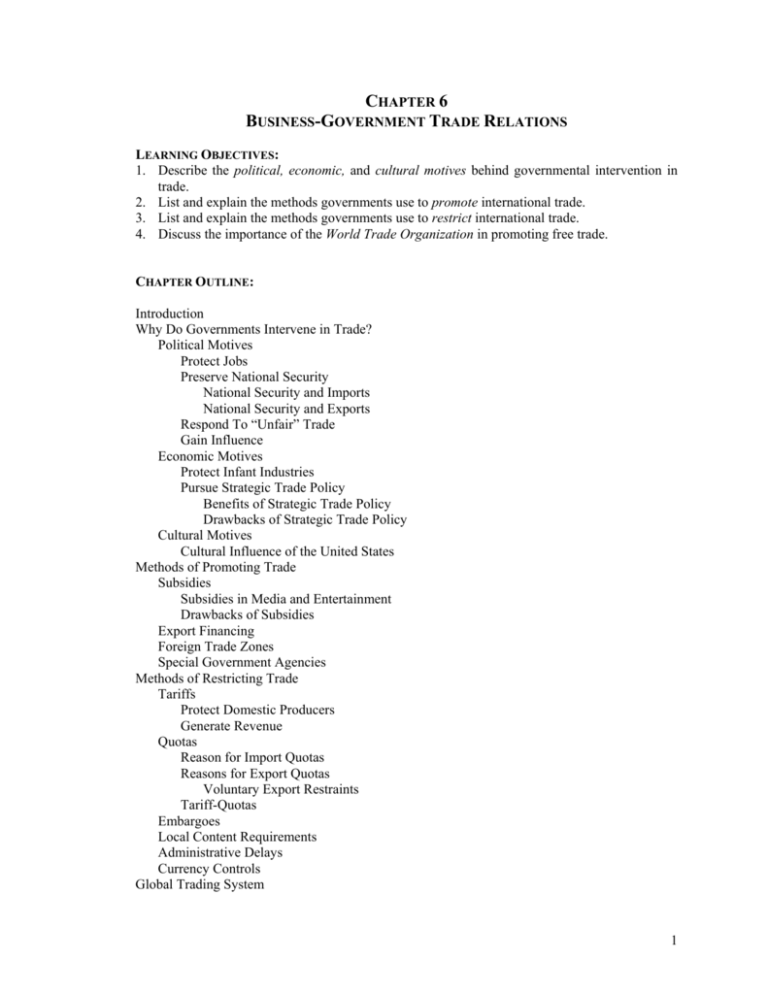
CHAPTER 6 BUSINESS-GOVERNMENT TRADE RELATIONS LEARNING OBJECTIVES: 1. Describe the political, economic, and cultural motives behind governmental intervention in trade. 2. List and explain the methods governments use to promote international trade. 3. List and explain the methods governments use to restrict international trade. 4. Discuss the importance of the World Trade Organization in promoting free trade. CHAPTER OUTLINE: Introduction Why Do Governments Intervene in Trade? Political Motives Protect Jobs Preserve National Security National Security and Imports National Security and Exports Respond To “Unfair” Trade Gain Influence Economic Motives Protect Infant Industries Pursue Strategic Trade Policy Benefits of Strategic Trade Policy Drawbacks of Strategic Trade Policy Cultural Motives Cultural Influence of the United States Methods of Promoting Trade Subsidies Subsidies in Media and Entertainment Drawbacks of Subsidies Export Financing Foreign Trade Zones Special Government Agencies Methods of Restricting Trade Tariffs Protect Domestic Producers Generate Revenue Quotas Reason for Import Quotas Reasons for Export Quotas Voluntary Export Restraints Tariff-Quotas Embargoes Local Content Requirements Administrative Delays Currency Controls Global Trading System 1 General Agreement on Tariffs and Trade (GATT) Uruguay Round of Negotiations Agreement on Services Agreement on Intellectual Property Agreement on Agricultural Subsidies World Trade Organization (WTO) Dispute Settlement in the WTO Dumping and the WTO Subsidies and the WTO Doha Round of Negotiations The WTO and the Environment Bottom Line for Business Implications of Trade Protection Implications of the Global Trading System A comprehensive set of specially designed PowerPoint slides (designated ‘PPT’ below) is available for use with Chapter 6. These slides and the lecture outline below form a completely integrated package that simplifies the teaching of this chapter’s material. Lecture Outline 1. INTRODUCTION This chapter explores business-government trade relations, considers why nations erect barriers to trade and explores the cultural, political, and economic motives for such barriers. It also examines the instruments countries use to restrict imports and exports, and how the global trading system promotes trade. 2. WHY DO GOVERNMENTS INTERVENE IN TRADE? Free Trade is the pattern of imports and exports that would result in the absence of trade barriers. Governments impose restrictions on free trade for political, economic, and cultural reasons. A. Political Motives (PPT #3) 1. Protect Jobs Short of an unpopular war, nothing will oust a government faster than high unemployment. All governments become involved when trade threatens jobs at home. 2. Preserve National Security Industries essential to national security receive government-sponsored protection for both imports and exports. a. Imports Governments restrict imports to guarantee domestic supply, which preserves national security. Many countries fiercely protect their agricultural sector for national security reasons because a nation that imports its food supplies could face starvation in times of war. b. Exports 2 3. 4. Governments have national security motives for banning certain defense-related goods from export to other nations. Agencies review requests to export technologies or products have dual uses—meaning they have both industrial and military applications. Respond to “Unfair” Trade Many argue that it makes no sense for one nation to allow free trade if others do not. Governments threaten to close their ports or to impose high tariffs if another nation does not concede on a certain trade issue. Gain Influence Governments of the largest nations may become involved in trade to gain influence over smaller nations. The United States wishes to maintain control over Central, North, and South America and the Caribbean basin. B. Economic Motives (PPT #4-5) 1. Protect Infant Industries The infant industry argument says that emerging industries need protection from international competition during development until they become competitive internationally. Protection can be removed after it gains the knowledge to become innovative, efficient, and competitive. a. Drawbacks Governments may make errors in distinguishing between industries worth protecting and those that are not. Protection can cause domestic firms to grow complacent toward innovation and limit their competitiveness and increase consumer prices. Small promising ventures today can get private funding. 2. Pursue Strategic Trade Policy New trade theorists believe government intervention helps firms take advantage of economies of scale and enjoy first-mover advantages. Firstmover advantages result because economies of scale limit the number of companies in an industry. a. Benefits Companies earn profits if they obtain first-mover advantages and solidified market positions. The chaebol helped companies survive poor economic times because of the wide range of industries in which they competed; policies had spin-off effects on industries such as transportation. b. Drawbacks Government assistance to domestic companies caused inefficiency and high costs for South Korean and Japanese companies in the late 1990s. Government support is subject to political lobbying and special-interest groups could capture gains with no benefit for consumers. C. Cultural Motives (PPT #6) Exposure to people and products of other countries slowly alters cultures. 1. Unwanted cultural influence causes great distress and can force governments to block imports. 2. Many countries have laws that protect their media programming for cultural reasons (e.g., French ban foreign words on radio and TV). 3 3. 3. The United States is seen as a threat to national cultures because of its global strength in consumer goods entertainment and media. This is where the theory of international trade meets the reality of international business today. METHODS OF PROMOTING TRADE A. Subsidies (PPT #8) A subsidy is financial assistance to domestic producers in the form of cash payments, low-interest loans, tax breaks, product price supports, or some other form. Intended to help domestic companies fend off international competitors. 1. Subsidies in Media and Entertainment Media and entertainment are commonly subsidized. 2. Drawbacks of Subsidies Some say subsidies cover costs that competitive industries should absorb, thus encouraging inefficiency and complacency. Because governments pay for subsidies with tax income, it is felt that subsidies benefit companies but harm consumers. Although subsidies provide short-term relief, the idea that subsidies are helpful in the long term is questionable. B. Export Financing (PPT #9) 1. Governments promote exports by helping companies finance their export activities through loans or loan guarantees. 2. Two agencies help U.S. companies gain export financing: Export-Import Bank and the Overseas Private Insurance Corporation (OPIC). OPIC insures against losses due to: (1) expropriation, (2) currency inconvertibility, and (3) war, revolution, and insurrection. 3. Financing is often crucial to small businesses just beginning to export. 4. Critics say subsidizing large multinational companies at taxpayer expense is corporate welfare. C. Foreign Trade Zones (PPT #10) 1. A foreign trade zone (FTZ) is a designated geographic region in which merchandise is allowed to pass through with lower customs duties (taxes) and/or fewer customs procedures. Goals are jobs and trade. 2. Customs duties increase production costs and the time it takes to get a product to market. Companies can reduce such costs and time by establishing a facility inside a foreign trade zone. 3. A common purpose of such zones is final product assembly. Lower customs duties are offset by the jobs created in the United States. 4. China established very large foreign trade zones to reap the benefits. 5. Mexico’s maquiladora zone: import materials from the US without duties, process them, and re-export them to the US, which charges duties only on the value added in Mexico. D. Special Government Agencies (PPT #11) 1. Governments have special agencies responsible for promoting exports. Such agencies organize trips for trade officials and businesspeople to visit other countries and open trade offices in other countries. 3. Governments not only promote exports but also may encourage imports (e.g., The Japan External Trade Organization (JETRO). 4 4. 4. Although finding out about government regulations in other countries can be daunting, information access is now easier on the Web. METHODS OF RESTRICTING TRADE A. Tariffs (PPT #12) 1. A tariff is a government tax levied on a product as it enters or leaves a country: (1) export tariff, (2) transit tariff, and (3) import tariff. 2. Types of import tariff: An ad valorem tariff is levied as a percentage of the stated price of an imported product. A specific tariff is levied as a specific fee for each unit (by number or weight) of an imported product. A compound tariff is calculated partly as a percentage of the stated price of an imported product, and partly as a specific fee for each unit. 3. Protect Domestic Producers Because import tariffs raise the cost of an imported good, domestically produced goods appear more attractive to buyers. But protection may cause domestic producers to become lax in increasing efficiency. 4. Generate Revenue Tariffs are a source of government revenue. Less-developed nations have less formal domestic economies that lack the capability to record domestic transactions accurately. Because this makes collection of sales taxes difficult, nations raise needed revenue through import and export tariffs. As countries develop, they generate a greater portion of their revenues from taxes on income, capital gains, and other economic activities. Tariffs exact a cost on countries because they lessen the gains from trade. B. Quotas (PPT #13) A quota is a restriction on the amount (measured in units or weight) of a good that can enter or leave a country during a certain period of time. Governments administer quota systems by granting quota licenses to other nations’ companies or governments (import quotas) and domestic producers (export quotas). 1. Reason for Import Quotas a. Protects domestic producers by placing a limit on the amount of goods entering the country. This helps domestic producers maintain market shares and prices by retraining competition. b. Domestic producers win because of market protection, but consumers lose because of higher prices and limited selection. Other losers include domestic producers whose production requires the import subjected to a quota; companies relying on imported intermediate goods find the final cost of their own products increase. 2. Reasons for Export Quotas a. A country may wish to maintain supplies in the home market. This is common for countries that export natural resources that are needed in the domestic market. b. A country may restrict supply on world markets to increase the international price. c. A voluntary export restraint (VER) is a unique version of export quota that a nation imposes on its exports, usually at the request of an importing nation. If domestic producers do not curtail 5 3. 5. production, consumers benefit from lower prices due to a greater supply. Export quotas hurt consumers in the importing nation because of reduced selection and higher prices. Export quotas might retain jobs if imports threatened to put domestic producers out of business. Tariff-Quotas A tariff-quota is a lower tariff rate for a certain quantity of imports and a higher rate for quantities that exceed the quota (e.g., agricultural trade). C. Embargoes (PPT #14) a. An embargo is a complete ban on trade (imports and exports) in one or more products with a particular country. It may be placed on one or a few goods or completely ban trade in all goods. It is the most restrictive nontariff trade barrier and often has political goals. b. Embargoes can be decreed by individual nations or by supranational organizations such as the UN. D. Local Content Requirements (PPT #15) a. Local content requirements are laws stipulating that producers in the domestic market must supply a specified amount of a good or service. Designed to force companies from other nations to employ local resources in their production processes—particularly labor. b. May help protect domestic producers from the price advantage of companies based in other, low-wage, countries. Developing countries use them to boost industrialization. E. Administrative Delays (PPT #16) a. Administrative delays are regulatory controls or bureaucratic rules designed to impair the rapid flow of imports into a country. b. Can include government actions such as requiring international air carriers to land at inconvenient airports, requiring inspections that damage the product, understaffing customs offices to cause delays, and requiring special licenses that take time to obtain. c. Objective is protectionism (e.g., Japan’s subtle obstacles to imports; vitamins, farm products, building materials). F. Currency Controls (PPT #17) a. Currency controls are restrictions on the convertibility of a currency into other currencies. b. Governments reduce imports by stipulating an exchange rate that is unfavorable to potential importers. Also can give exporters favorable rates to encourage exports. GLOBAL TRADING SYSTEM World trade volume peaked in the late 1800s. US Smoot-Hawley Act in 1930 shifted nation from free trade to protectionism. Smoot-Hawley, and global trade wars it ushered in, crippled industrialized nations and helped spark the Great Depression. A. General Agreement on Tariffs and Trade (PPT #18) 6 The GATT was a 1947 treaty designed to promote free trade by reducing both tariff and non-tariff barriers to international trade. Success in GATT’s early years began to wane in the 1980s. 1. Uruguay Round of Negotiations The Uruguay Round made significant progress in reducing trade barriers by revising and updating GATT. a. Services The General Agreement on Trade in Services (GATS) extended principle of nondiscrimination to cover international trade in all services. The GATS identifies four forms of services. • Cross-border supply: Services supplied from one country to another (e.g., international phone calls). • Consumption abroad: Consumers or companies using a service while in another country (e.g., tourism). • Commercial presence: Company’s subsidiary in another country provides a service (e.g., banking operations). • Presence of natural persons: Individuals traveling to another country to supply a service (e.g., business consultants). b. Intellectual Property i. Intellectual property refers to property that results from people’s intellectual talent and abilities and is legally protected by copyrights, patents, and trademarks. ii. Uruguay Round took a step toward getting intellectual property under control; it created the Agreement on Trade-Related Aspects of Intellectual Property (TRIPS) to standardize intellectual-property rules. c. Agricultural Subsidies i. Popular barriers to protect agricultural sectors include import quotas and subsidies paid to farmers. ii. Uruguay Round increased exposure of national agricultural sectors to market forces and increased predictability in international agricultural trade. iii. Forces countries to convert nontariff barriers to tariffs and calls for cutting of agricultural tariffs significantly. B. World Trade Organization (PPT #19) World Trade Organization (WTO) is the international organization that regulates trade between nations. Three main goals of the WTO are to: (1) help free trade; (2) negotiate opening of markets; and (3) settle trade disputes. Key component of the WTO is normal trade relations: WTO members must extend the same favorable terms of trade to all members that they extend to any single members. WTO absorbs the GATT agreements into its own agreements. 1. Dispute Settlement in the WTO a. WTO’s power to settle trade disputes sets it apart from the GATT. WTO agreements are contracts between member nations that commit them to maintaining fair and open trade policies. b. When a member files a complaint, the Dispute Settlement Body of the WTO renders a decision in less than one year. Offenders must realign policies according to WTO guidelines or suffer financial penalties and perhaps trade sanctions. 7 2. 3. 4. 5. 6. Dumping and the WTO a. WTO gets involved in settling disputes that involve “dumping” and the granting of subsidies. Dumping occurs when a company exports a product at a price that is either lower than the price normally charged in its domestic market, or lower than the cost of production. b. Because dumping is an act by a company, not a country, the WTO cannot punish the country in which dumping is based. c. WTO allows a nation to retaliate against dumping if it proves dumping charges, calculates the damage, and can show the damage is significant. Nations retaliate by imposing an antidumping duty—an additional tariff placed on an imported product that a nation believes is being dumped on its market. Subsidies and the WTO a. Governments retaliate when the competitiveness is threatened by a subsidy that another country pays domestic producers. A countervailing duty is an additional tariff placed on an imported product that a nation believes is receiving an unfair subsidy. b. WTO regulates the actions of the government that reacts to the subsidy and the one that imposes the subsidy. New Round of Negotiations a. Negotiations began in Doha, Qatar, in late 2001. The new round could bring particular benefits for developing nations. b. Poor countries should obtain greater access to rich countries’ textile markets and other markets that are labor intensive. Poor nations are to receive help from rich nations in integrating themselves into the global trading system. WTO and the Environment a. Rapid industrialization in many developing and emerging economies has generated environmental concerns among governments and special-interest groups. b. WTO has no separate agreement for environmental issues, but works with 200 international agreements on the environment. c. But the WTO has a Committee on Trade and Environment to study the relationship between trade and the environment and to recommend changes in the WTO trade agreements. d. WTO also takes explicit positions on some environmental issues related to trade. It states that labeling requirements or policies cannot discriminate against the products of other WTO members. It also supports policies of the least-developed countries that require full disclosure of potentially hazardous products for reasons of public health and environmental damage. BOTTOM LINE FOR BUSINESS Despite the theoretical benefits of trade, nations do not simply throw open their doors to free trade and force all their domestic businesses to sink or swim. This chapter has discussed reasons why national governments continue to protect all or some of their industries and how they go about it. The global trading system through the World Trade Organization tries to strike a balance between national desires for protection and international desires for free trade. 8
